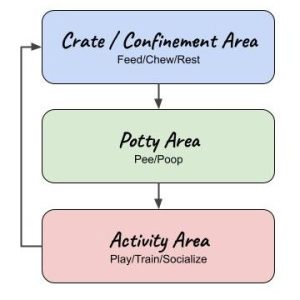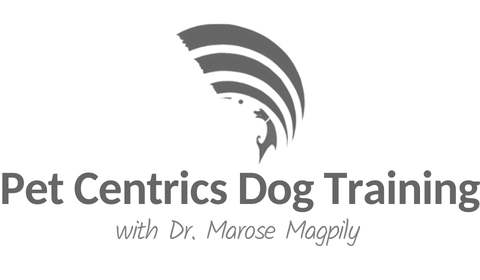An unguided puppy, allowed to get into trouble and make mistakes, often causes us to react with verbal reprimands and physical punishment to stop the puppy’s unwanted behaviors. But while punitive or harsh punishment can be effective in suppressing problematic behaviors, it does little to actually teach the dog how to properly behave. Further, a reactive punishment-based approach potentially causes even greater behavior issues to develop and can damage your relationship with your puppy.
The alternative I would encourage new puppy owners to adopt involves a proactive mindset and the use of modern, science-based and humane methods of dog training.
Predict Your Puppy’s Needs
Most naughtiness is an expression of the puppy’s unattended and unfulfilled needs and wants. House soiling means a puppy was left to relieve itself without guidance. Puppy biting means a puppy is looking for attention and play. Destructive chewing means a puppy is fulfilling its natural need to chew and work its teeth.
Once you adopt a proactive mindset, you begin to anticipate your puppy’s needs and wants ahead of time allowing you to prevent and manage undesirable behaviors before and when they happen. At the same time, you will be humanely guiding the puppy and teaching him alternative behaviors that are desirable and appropriate for accessing his needs and wants.
For example, thinking and acting proactively means you would plan and maintain a good daily routine to give your puppy plenty of opportunities to relieve himself where appropriate so that house soiling is minimal. You would schedule and initiate adequate amounts of play, training and exercise with your puppy so that he does not feel the need to engage in attention-seeking playful biting. You would keep your puppy crated while unsupervised and provide him with enticing chew items so he has ways to express his chewing habit while confined.
Think Like A Puppy
As they say, knowledge is power. If you know what motivates your puppy and how he learns, you can stay ahead of your puppy’s naughtiness and you can even prevent him from learning naughty behaviors in the first place. So take some time to understand the fundamental concepts of puppy behavior and learning. Not only will your planning go more smoothly. It will help you be more patient, empathetic and compassionate towards your puppy when you understand your puppy’s motivations for behaving as he does. It will also help you troubleshoot your way through unforeseen puppy-rearing issues later.
Have A Plan
Proactive thinking means you have foresight and clear goals: know what to expect and what you mean to achieve with your puppy. Alongside knowing and anticipating how a puppy might act driven by his needs and wants, you should also consider how you would like him to behave and what rules you would like him to observe that would still allow him to access those needs and wants. So think: Where exactly would you want your puppy to pee and poop? What is an acceptable form of play? What activities are appropriate outlets for play biting and chewing? Where is your puppy allowed to sleep? How would you like your puppy to walk with you?
Always think about what works best for you. What rules make sense for you and your lifestyle? What is allowable and what are absolute NOs with regards to your dog’s behavior?
Gather Your Equipment
Puppy-rearing and dog training requires the right equipment. Here are some of the basics you’ll want to have at the ready:
- an appropriately-sized crate
- an exercise pen (or baby gates)
- a leash and collar
- food and water bowl
- healthy training treats
- chew items
- dog toys
Aside from these, you may also want to invest in a long line and harness, a training pouch to hold your treats, and a clicker. In a later blog post, I’ll talk in greater detail about the equipment I like to prepare for training a new dog and how to use these.
Prepare The Environment
As I mentioned, pro-active dog training requires preparation. This includes preparing the environment in which your puppy will be moving about. Think about these three important areas that will be regularly accessible to your puppy:
- A Confinement / Resting Area – this may be a crate or a larger enclosure or room that has been puppy-proofed. It will be the place where your puppy is kept when you are unable to actively supervise him.
- A Potty Area – this is the designated area for where your puppy is allowed to pee and poop. It should be easy to access and easy to clean, and should be near the resting area so you can immediately bring your puppy there when he wakes from sleep.
- An Activity Area – these are areas where you will spend time with your puppy playing and training. Sometimes, the confinement area can double as the activity area, especially in the beginning when your puppy first starts living with you. If the activity area is not puppy-proofed, it’s important that you keep your puppy occupied and supervised while staying in these areas.
Make A Daily Schedule
Your daily schedule for your puppy should include three essential parts: Resting Time, Potty Time and Activity Time, which will make up one cycle (see figure below). This cycle will be repeated several times a day, the number of which depends on how old your puppy is and on needs that are specific to your particular puppy.

As with Equipment I’ll discuss the activity cycle in greater detail later on. But just following this simple plan for how to structure your day will help keep you on track for attending to all your puppy’s needs at the right time and in adequate amounts.
Of course, things will not always go smoothly. Always leave room for making adjustments, and don’t let yourself be too bothered if your schedule is not followed to the letter. Puppies are living beings that have minds of their own, so when the puppy’s mood strikes or when life happens it is natural for your day to be disrupted. In that case, having a plan will help you quickly get back into your routine. And routines are important for staying consistent with training your puppy the house rules and good manners.
Find The Right Guide
It’s not always necessary to get help from a professional but it can be helpful to have someone available who you can ask for advice and who can help you troubleshoot when things don’t always go to plan.
Dogs are family, so finding a dog trainer you can trust is important and should not be decided on lightly, especially if you are committed to being proactive and to using only humane, modern and science-based dog training techniques. Here are some points to consider when searching for your dog training guide:
- A good dog trainer should be well-versed in dog learning and dog behavior, and he or she is up to date with the latest training techniques. They should have a good understanding of how various types of dog training equipment (even the equipment they don’t personally prefer) are used.
- Dog training should be about teaching the dog and not about constantly policing him. It is unfair to repeatedly punish or correct a dog when he makes a mistake if no effort has been made to teach the dog how to be right. Therefore, stay away from trainers who address misbehavior solely through intimidation and force, with no other tools at their disposable for getting the dog to understand and do what is required.
- Dog training is about communication. Your dog trainer should communicate well, not just with your dog, but with you the owner. Your dog trainer should be available and able to answer questions about your dog’s training, be able to explain why they recommend one training method over another, and be able to explain the principles behind the dog training techniques they use.
- Dog training is about empowering the dog owner to work with their own dog. Make sure the trainer you select is one who encourages you to participate in the training and who emphasizes the importance of growing the relationship between you and your puppy.
Take Action!
Puppy training can be fairly simple and it can definitely be fun, but be prepared to give it time and effort. All the best advice and well laid out plans are worth nothing if you are not committed to taking action. Be patient and stick to the program. Your puppy’s naughty behaviors will not disappear overnight or after just one session of training. There are no quick fixes to getting a well-behaved, well-mannered pup. There is no magic equipment that will help produce instant good behavior. The results of your efforts will be gradual but as you continue to move forward with your dog, at some point you’ll look back and be amazed how far you’ve come.
Armed with the proper knowledge, a plan and a commitment to take action, I am confident that your puppy training journey will be an exceedingly enjoyable experience that you’ll be proud to have invested your time in, and from which you and your dog will grow a beautiful, loving bond.
Sign Up for Free Dog Training 101 Resources
If you’ve read this far, I hope it means that I’ve convinced you that proactive, humane and modern dog training methods are the way to build the relationship with your new puppy. Embarking on this journey with your dog, I am happy to share more of my knowledge, and help you formulate a plan for rearing and training your canine companion.
It can be immensely overwhelming to think about all the things you need to plan for with regards to your new puppy. But I want to offer my own experiences and what I’ve learned from them to give you a starting point and to guide you along the way. To get you off to a good start, I’ll gladly share with you the proactive steps you need to take for managing your puppy, which will include strategies for preventing common naughty puppy behaviors such as house soiling, indiscriminate chewing and puppy play biting. You can adapt this plan to meet your needs and your goals for yourself and your puppy. Subscribe to the Pet Centrics email list and I’ll send you the information you need directly to your inbox.
Should you need more help, the Pet Centrics Dog Training 101 course is available to you so that you can get personal instruction from me and learn the basic skills you need to implement the plan.
Enjoy the Journey!
Lastly, don’t forget to have fun. At times when your puppy is proving particularly difficult, it may be hard to see past the trouble your puppy is causing and the chaos that he leaves in his wake. Don’t take things personally. Your puppy is trying to understand this human world he is living in. Be patient with your guidance, learn to laugh at the mischief and take lessons from your puppy-rearing mistakes.
This is what is so precious about having the company of dogs in our lives: they teach us to value the moment, to let loose and let go. Stay pro-active and think positive. Look ahead to all the amazing moments you and your dog will have together.
Up Next: Equipment and Prep
We’re just about ready to get into the thick of training our young dogs. Next, we’ll talk about some equipment that you’ll need to acquire and a few other things that you need to prepare. Then we’ll talk about the actual plan for how to go about training your pup.

